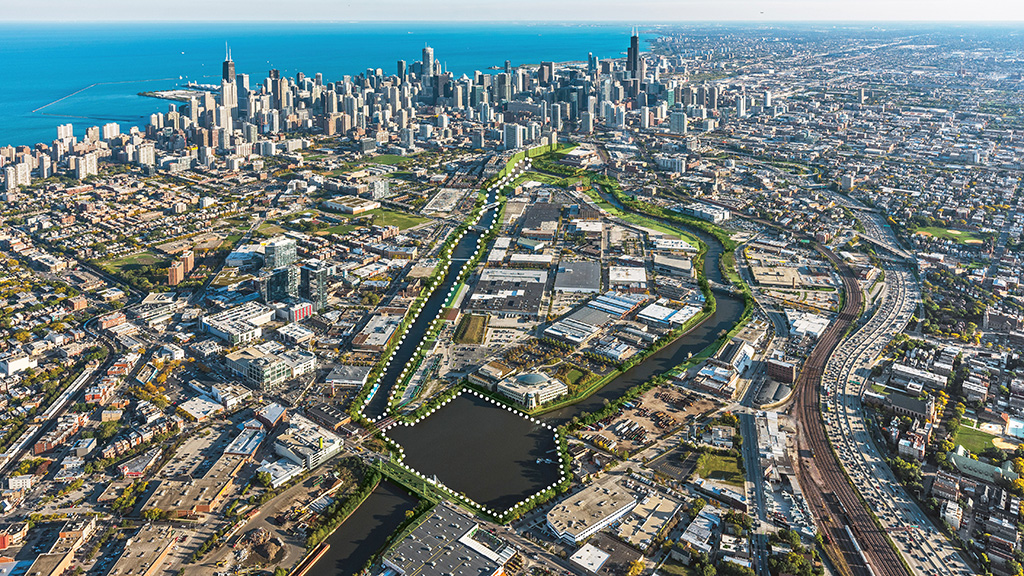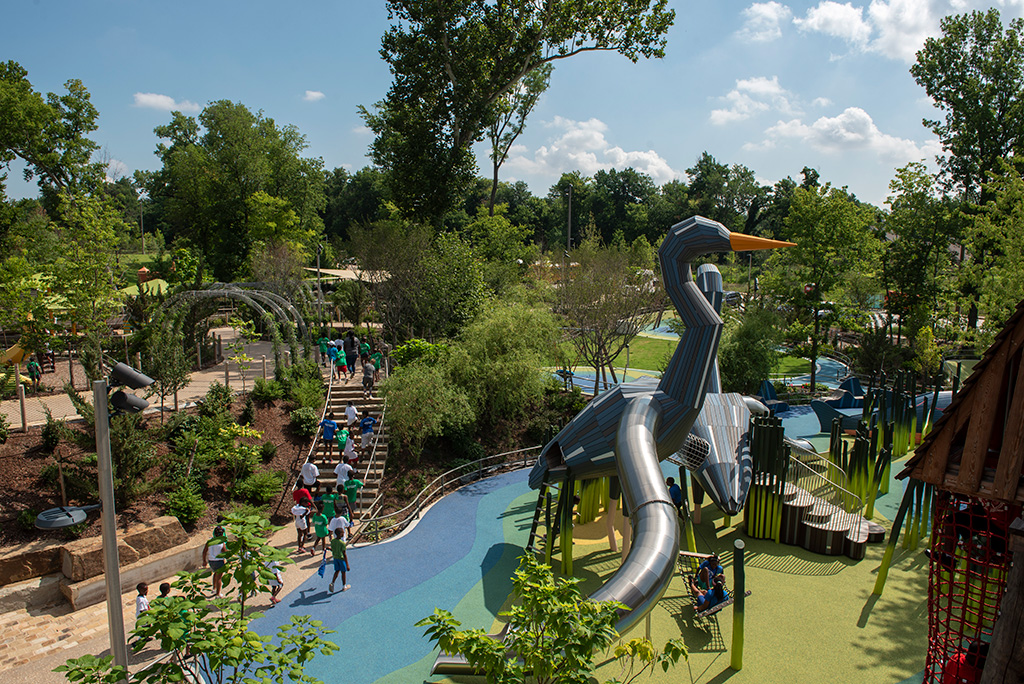A version of this story appeared in the fall 2019 issue of Uncommon Path.
Old and famous city parks are good fakes. If you wander deep enough and keep your gaze below the treetops, the wide lawns and leafy forests let you imagine that you’re traveling through bucolic countryside. That’s the idea—an illusion of country in the city.
But the newest urban retreats are taking a different approach. “How do you take something that’s already built and has so much infrastructure around it and use that in the next phase of what a city wants?” says Nick Wesley, who is developing one such park in Chicago.
Several cities are aiming for spaces that embrace their location and give locals more intersections with the outdoors. In Tulsa, Oklahoma, a new destination blends classic nature features with intricate playgrounds and relaxing nooks. In Atlanta, green spaces woven around a planned transit overhaul ease living, working and commuting in a congested metro area. And in Chicago, a stretch of plants floating in the river wraps educational opportunities into a greenery-laced boardwalk. These aren’t the only unusual green spaces cropping up around the country, but they’re among the leaders in reimagining the city park for a new age.
Wild Mile
Chicago, Illinois

Photo Credit: Curtis Waltz, Aerialscapes Inc. and diagram by Som
One day last year, the fourth-graders at the British International School of Chicago packed up for a unique field trip. They kayaked out into a former shipping canal on the Chicago River—once a wilderness of concrete and steel—to rafts harboring native plants that will help clean the water and welcome home birds, fish and amphibians. Their teacher, Tom Collins, was eager to immerse them in the early phases of the Wild Mile, a first-of-its-kind floating eco-park slated for completion in 2020. “To put native species back in the waterway will help [students] learn about local wildlife and kick-start the need to look for wildlife all over,” he says.
The Wild Mile will provide places to kayak and learning stations among floating gardens, forests and wetlands, with a boardwalk snaking through it all. Even the park’s creation is an exercise in communing with the natural habitat, says Wesley, the cofounder of Urban Rivers, the nonprofit leading the project. “We’re still learning what plants work, so students are contributing to the body of knowledge we have about this,” he says. “That’s one of the coolest things about this concept.” Wesley plans for science lessons at the Wild Mile to eventually become available to all Chicago schools, no matter their budget.
Atlanta BeltLine
Atlanta, Georgia
At their best, parks don’t just get people outdoors—they also create connections. The concept for the Atlanta BeltLine revolves around the transformation of a 22-mile loop of railroad corridors that wends through 45 neighborhoods and 1,300 acres of parks. When complete, walking and cycling trails will run along the extended city streetcar system and lead visitors through transformed industrial sites, says spokesperson Jenny Odom. “Historically, railroads divided neighborhoods and were a no-man’s-land,” she says. “By removing barriers between neighborhoods, we’re seeing people coming together.”
To keep the area livable, the city requires that the BeltLine eventually offer 5,600 units of affordable housing. The project had only secured a fraction of that by July 2012, a dozen years after the BeltLine Partnership was formed, according to an investigation by the Atlanta Journal-Constitution. But 1,640 affordable housing units were created or preserved by April of this year. The BeltLine is projected to wrap in 2030.
Gathering Place
Tulsa, Oklahoma

Gathering Place was designed by Michael Van Valkenburgh Associates, the firm behind Maggie Daley Park in Chicago and the Brooklyn Bridge Park in New York City. (Photo Credit: Nick Oxford for The New York Times)
Gathering Place, a roughly 70-acre park in midtown, debuted in fall 2018. Picture a free-form landscape with sculptural playgrounds, elevated gardens, 26 miles of trails, a boathouse and a huge indoor hangout space—a rare asset in cities. George Kaiser, a local billionaire, proposed the $465 million riverfront park to help Tulsa attract companies and keep college grads, says executive director Tony Moore.
Gathering Place hosted more than a million visitors in the first five months, and USA Today readers named it the best new attraction for 2019. The park is also a popular meeting spot for Mental Health Association Oklahoma’s Creating Connections program, allowing participants to connect with their community and environment in a new way. “Some of the challenge for adult participants is that a lot of free or low-cost events are geared toward younger audiences,” says Clinical Director of Services Beth Edwards Svetlic, “but we all need some of that sometimes.”
Next up for the park: developing private partnerships for busing in students and families from low-resource areas who can’t access it today. For now, says Moore, “We like the fact that the East Coast and West Coast are taking note and saying, ‘Tulsa? Wow!’”
Leading the Wave
Each of these parks comes with a blueprint for growth. The Wild Mile will plan to get more citizen scientists collecting data on the local plant life; the BeltLine hosts an urban farm and may add more plots around the project; and Gathering Place has another 30 acres and a children’s museum planned.
With expansion comes adaptation. “There’s understanding planned, theoretical use, and then there’s seeing what it’s actually like,” says Tony Moore of Gathering Place. But being early to a movement has its rewards too, says Wesley of the Wild Mile. “Cities copy each other— we hope others will copy us too.”
Atlanta BeltLine Partnership has been a nonprofit partner of REI since 2005, and Urban Rivers has been a nonprofit partner of REI since 2017. REI contributions totaling $133,350 and $11,000, respectively, have helped support the two organizations’ efforts over the years.


